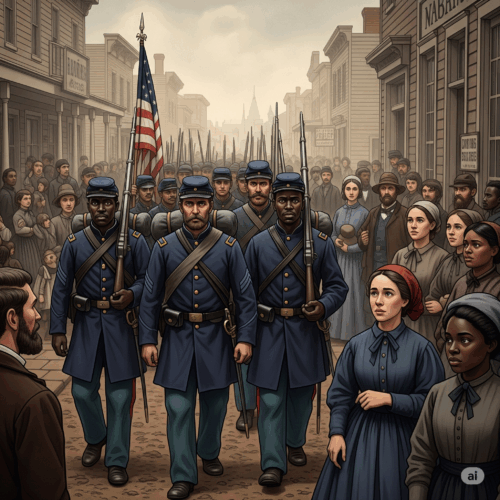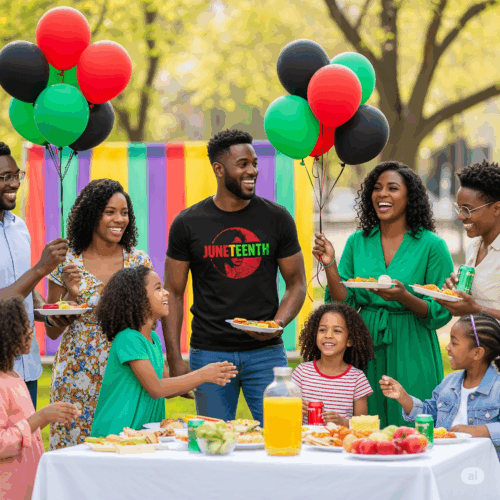Every individual, at some point in their journey, experiences a profound yearning to break free – whether it is from a limiting belief, a stagnant routine, or an unspoken fear that holds them captive. Certain dates in history resonate with a deep, almost sacred significance, serving as powerful reminders of pivotal moments of liberation. Today, June 19th, is one such date, etched with a powerful story of freedom finally realized.
This day commemorates Juneteenth, a pivotal moment on June 19, 1865, when the last enslaved people in the Confederate states, specifically in Texas, finally received the official news of their freedom. This monumental announcement arrived more than two years after President Abraham Lincoln’s Emancipation Proclamation had legally declared them free. The narrative of Juneteenth is not merely a historical account; it is a timeless wellspring of lessons for individual journeys toward liberation, offering a powerful blueprint for breaking free from the “chains” that bind people today. The inherent power of this historical narrative, with its themes of delayed freedom and personal agency, serves as a compelling catalyst for inspiring personal breakthroughs. It underscores how a significant historical event can offer profound guidance for contemporary challenges, transforming a distant past into an immediate source of empowerment.
The Unfolding of a Delayed Truth: Galveston, June 19, 1865
The American Civil War concluded in April 1865 with General Robert E. Lee’s surrender, yet the promise of freedom articulated by President Abraham Lincoln’s Emancipation Proclamation on January 1, 1863, remained a distant whisper for many enslaved individuals. While the proclamation declared over three million enslaved people in Confederate states free, its practical application was uneven and often delayed.
Texas stood as a notable outlier in this unfolding narrative of liberation. Many African Americans remained enslaved, not only in Confederate states but also in border slave states that had remained loyal to the Union. Crucially, in Texas, numerous plantation owners actively refused to acknowledge the war’s conclusion and steadfastly declined to release their enslaved workers from bondage, even after Lee’s surrender. This deliberate suppression of truth and a stubborn clinging to an outdated reality prolonged the suffering of hundreds of thousands. This historical delay in the realization of freedom in Texas offers a compelling parallel to personal experiences where individuals might resist, be unaware of, or have their potential suppressed by internal or external forces. Just as a decree of freedom was issued but not immediately implemented, individuals often possess an inherent truth about their capabilities or desires that remains unacknowledged or unrealized, preventing their full liberation.
The pivotal moment arrived on June 19, 1865, when Major General Gordon Granger and a contingent of some 2,000 Union troops entered Galveston, Texas. This was more than a mere military presence; it was the physical manifestation of a long-awaited truth finally arriving. Granger delivered General Order No. 3, which explicitly declared that all enslaved people in Texas were free under the provisions of the Emancipation Proclamation. For many enslavers and enslaved people in Texas, this was the first time they learned that slavery had been abolished. The weight of those words, delivered in person, shattered a deeply entrenched lie, initiating a profound shift in reality for countless individuals.
The immediate reactions to this life-altering news were varied and powerful. They ranged from silent disbelief and shock, as the enormity of the announcement settled in, to profound celebrations filled with prayer, feasting, song, and dance. It was a moment of overwhelming emotional release, a dawning of a new reality after generations of oppression.
An often-overlooked yet vital component of this liberation was the proactive role of the 25th Army Corps. Comprised of more than 1,000 African-descendant soldiers, this brigade arrived in Galveston and captured the city on June 5, 1865, a full week before Granger’s official announcement. They pursued the rebel government and soldiers into Mexico and, crucially, began to spread the word about freedom themselves. Civil War historians estimate that thousands of enslaved people escaped to freedom because of the actions of the 25th Army Corps, even before the formal declaration. This pre-emptive action underscores a deeper understanding of liberation: while official decrees are vital, individual and collective agency can significantly accelerate and amplify the path to freedom. It demonstrates that freedom is not solely a passive reception of external decrees but is often catalyzed by active pursuit and mutual support.
 More Than a Date: The Enduring Spirit of Juneteenth
More Than a Date: The Enduring Spirit of Juneteenth
In the immediate aftermath of Granger’s announcement, Juneteenth rapidly evolved from a specific event into an annual tradition. The first celebrations in Texas on June 19, 1866, were deeply meaningful, involving prayer meetings, the singing of spirituals, and the profoundly symbolic act of wearing new clothes to represent newfound freedom. This transformation from a single day of announcement to an enduring holiday speaks volumes about its significance and the deep human need to commemorate liberation.
The celebration quickly spread beyond Texas, becoming known by various names such as Emancipation Day, Jubilee Day, and Freedom Day. This widespread adoption highlights the deep resonance of the message of liberation across African American communities throughout the nation. The act of “wearing new clothes” during these early celebrations carries a powerful symbolic weight. It was not merely about donning new garments; it signified a profound internal and external transformation, representing the shedding of an old, constrained identity and the deliberate embrace of a new, empowered self. This powerful symbolic parallel offers a guiding principle for personal development: actively adopting new habits, mindsets, or even external presentations can reinforce and solidify internal shifts towards personal liberation.
Juneteenth’s symbolic meaning extends beyond the mere end of slavery; it represents the ongoing African American struggle for freedom and equality. It became, and remains, a vibrant celebration of family and community, a time for reflection on resilience, acknowledgment of progress, and renewed hope. The establishment of dedicated spaces, such as the first official Emancipation Park founded in Houston in 1872, further solidified its communal importance. The creation of such a park highlights a valuable lesson from history: for personal liberation to be sustained, individuals need not only internal resolve but also supportive external environments and networks. A park, as a place for gathering, reflection, and ongoing community building, serves as a tangible anchor for the intangible concept of freedom, emphasizing that liberation is nurtured and reinforced within a supportive community.
The enduring significance of Juneteenth was formally recognized when it was established as a legal public holiday in 2021. This modern acknowledgment underscores its continued relevance and the ongoing journey towards full understanding and appreciation of its historical weight. The historical celebration of Juneteenth connects profoundly with universal human desires: the longing for freedom, the strength found in community, the power of perseverance, and the importance of acknowledging and celebrating progress, no matter how long the journey. This historical narrative serves as a powerful mirror for contemporary life, reflecting shared aspirations and challenges.
 Your Personal Juneteenth: Breaking Free Today
Your Personal Juneteenth: Breaking Free Today
The historical narrative of Juneteenth, while rooted in the profound injustice of physical bondage, offers a powerful lens through which to examine contemporary individual struggles. While individuals today may not face literal chains of physical slavery, many are bound by invisible constraints: limiting beliefs, the fear of failure, the paralysis of procrastination, unhealthy habits, the weight of societal expectations, or the quiet whisper of self-doubt. These are the modern “chains” that prevent individuals from living their fullest, most authentic lives. The conceptual expansion of “chains” to encompass psychological, emotional, and societal limitations allows the historical narrative to resonate universally and become actionable for a modern audience, without diminishing the gravity of the original context.
These internal and external constraints can be framed as one’s personal “Texas,” a place where the truth of one’s potential, desired freedom, or inherent worth has not yet fully arrived or been acknowledged. One might intellectually “know” they deserve better, or that a change is necessary, but they have not truly “received” that truth in a way that sparks decisive action.
Drawing a direct parallel to the two-year delay of freedom in Texas, it prompts reflection: What “truths” about one’s capabilities, desires, or potential have been “proclaimed” (perhaps by an inner voice or by supportive friends) but not yet fully “delivered” or realized in one’s life? This could manifest as a dream deferred, a necessary change continuously postponed, or a self-defeating belief that needs to be shed.
The historical narrative of Juneteenth provides a powerful impetus for self-reflection and decisive action. Just as freedom was delayed but not denied in 1865, personal liberation moments are waiting for individuals to act. The echoes of the past serve as a powerful reminder that the power to break free lies within.
 A Blueprint for Liberation: Your Juneteenth Action Plan
A Blueprint for Liberation: Your Juneteenth Action Plan
This section offers a practical blueprint for personal liberation, intricately woven with the powerful symbolism of Juneteenth. The entire structure of this action plan is designed to mirror the historical journey of liberation, making the advice not just practical but deeply meaningful and memorable.
- Acknowledge Your Chains: Your Personal “Emancipation Proclamation”
Just as President Lincoln’s proclamation named the problem of slavery, the first step towards personal freedom is to honestly identify what truly binds an individual. What are the limiting beliefs, fears, unhealthy habits, or external pressures that prevent a person from living fully and authentically? This requires deep, often uncomfortable, self-reflection. True liberation cannot begin until what holds one back is acknowledged.
Action: Dedicate a quiet 15-30 minutes for introspection or journaling. List 3-5 specific “chains” that an individual wishes to break free from. Be brutally honest. Examples include: “Fear of failure,” “Procrastination on important tasks,” “Constant need for external validation,” or “Unhealthy spending habits.”
- Seek Your “General Order No. 3”: The Truth That Sets You Free
For the enslaved people in Texas, Major General Granger’s General Order No. 3 was the definitive, undeniable truth that shattered their reality of bondage. What “truth” does an individual need to hear, learn, or internalize to break their chains? This might be new knowledge, a different perspective, the courage to accept a difficult reality, or simply the realization that one is worthy and capable. The truth was present, but it needed to be delivered and accepted.
Action: Actively seek information, mentorship, or professional guidance related to the identified chains. Read books, listen to podcasts, watch documentaries, talk to trusted advisors, or consider therapy. For example, if procrastination is a chain, research productivity strategies; if self-doubt, seek affirmations, mindfulness practices, or cognitive behavioral techniques. Determine what knowledge will serve as a personal “General Order No. 3.”
- Embrace the “Galveston Moment”: Take the First Brave Step
The moment Granger arrived in Galveston was the turning point, the physical manifestation of freedom. What is an individual’s “Galveston moment”? It is the courageous, often uncomfortable, first step taken towards personal freedom. This is not about achieving perfection immediately; it is about decisive action, even if it is small. Recall the 25th Army Corps who acted and spread the word even before the official declaration – they did not wait for perfect conditions.
Action: Choose ONE small, immediate action related to one of the identified chains. Make it achievable within 24-48 hours. For instance, if it is procrastination, commit to 15 minutes of focused work on a dreaded task. If it is fear of public speaking, sign up for a local Toastmasters club or practice speaking in front of a mirror for 5 minutes. The crucial element is to act.
- Dress in “New Clothes”: Adopt New Habits and Mindsets
The newly freed people wore new clothes as a powerful, visible symbol of their transformed identity and newfound freedom. What new habits, mindsets, or routines will an individual “wear” to embody their liberated self? This involves actively cultivating the person one aspires to become, shedding the old patterns that kept them bound.
Action: Identify 1-2 new habits or mindsets that directly align with desired freedom. Start small and build consistency. If financial freedom is the goal, begin tracking every dollar spent daily. If mental clarity is sought, initiate a 5-minute daily meditation practice. If overcoming negativity is the aim, practice daily gratitude. These new “garments” will reinforce a new identity.
- Celebrate Your Small Freedoms: Acknowledge Progress and Find Joy
Juneteenth celebrations were filled with prayer, feasting, song, and dance. Freedom is not solely a distant destination; it is a journey marked by countless milestones. Celebrate every small victory, every chain broken, every step forward, no matter how minor. This reinforces positive behavior, builds momentum, and fuels motivation for the next step.
Action: After taking a brave step or adopting a new habit, acknowledge it. This could be a moment of quiet gratitude, sharing progress with a trusted friend, or a small, healthy reward (e.g., a favorite tea, a walk in nature). Do not wait for the “big win” to celebrate; every step is a triumph.
- Build Your “Emancipation Park”: Cultivate Supportive Communities
The establishment of Emancipation Parks demonstrates the profound importance of dedicated spaces and supportive communities in sustaining freedom. Who are the people who uplift, challenge positively, and celebrate an individual’s growth? Create a personal “park” of supportive relationships – a safe space where one can be their authentic, liberated self. Juneteenth is also a “celebration of family and community”, emphasizing the collective aspect of freedom.
Action: Identify 2-3 individuals who embody the support, wisdom, or positive energy needed. Actively nurture these relationships. Seek out communities (online or offline) that align with personal goals and values. Consciously limit exposure to those who reinforce “chains” or drain energy.
- Commit to Ongoing Liberation: Freedom as a Continuous Journey
Juneteenth was not the end of the struggle for equality, but a crucial beginning. The holiday has been celebrated since 1866 and only became a federal holiday in 2021, underscoring that freedom, justice, and growth are ongoing processes. Similarly, personal liberation is an unending journey. There will be new challenges, new “chains” to identify, and new truths to embrace. Commit to lifelong growth and self-awareness.
Action: Schedule regular “check-ins” (weekly or monthly) to reassess progress, identify new areas for growth, and adjust the plan. View setbacks not as failures, but as learning opportunities that refine the path to deeper freedom.
 Conclusion: The Unending March Towards Freedom
Conclusion: The Unending March Towards Freedom
Juneteenth, a day born from a delayed truth and hard-won freedom, stands as a powerful, timeless reminder that truth, courage, and community can break even the most entrenched chains—whether they are historical burdens or deeply personal limitations. The narrative of June 19, 1865, is not just a chapter in history; it is a living testament to the human spirit’s capacity for resilience and liberation.
The power to liberate oneself from limiting beliefs, fears, and old patterns lies within, waiting to be unleashed. Just as the news of freedom finally reached Galveston, the truth of one’s own potential is waiting to be fully received and acted upon. Embrace this historical echo as an invitation to embark on a personal “Juneteenth moment” today. Your personal freedom day is waiting, ready to dawn with every courageous step you take towards your authentic self.

